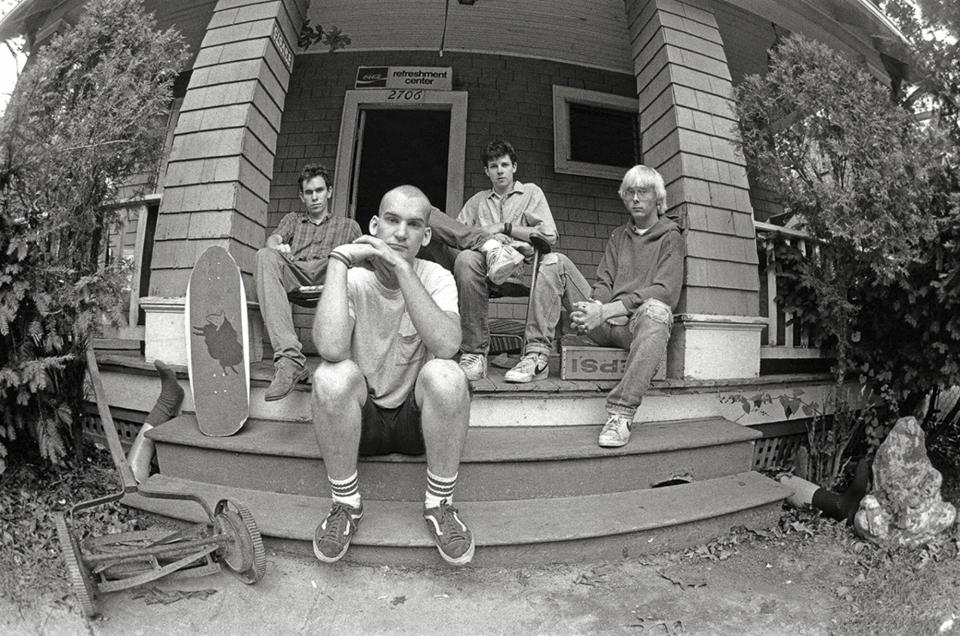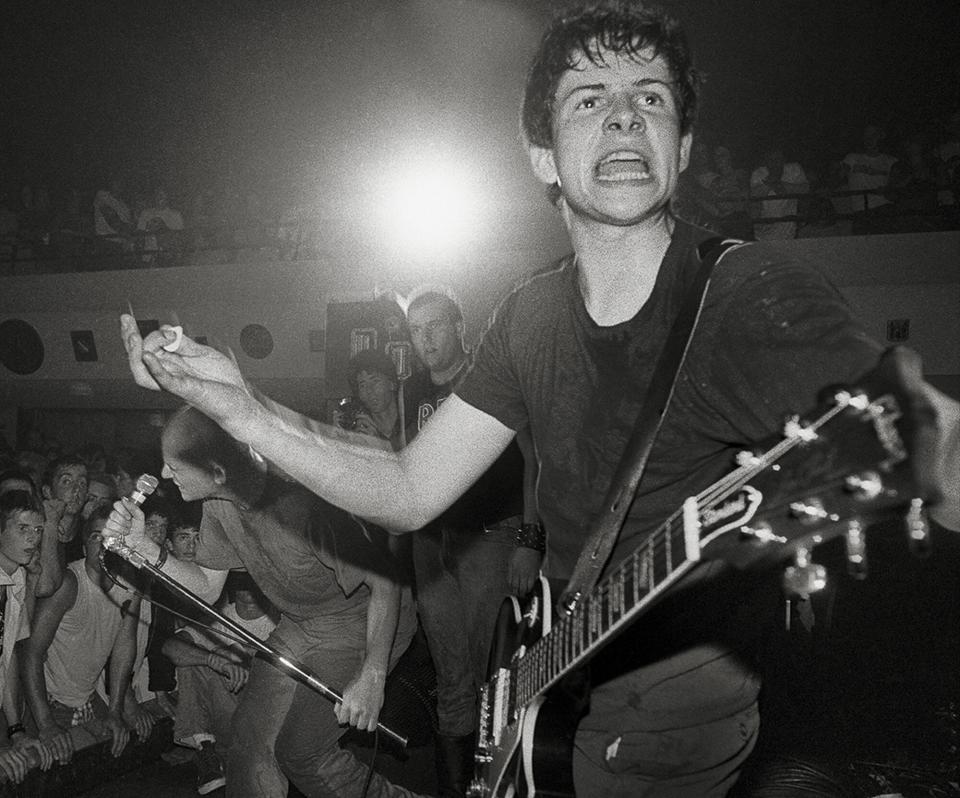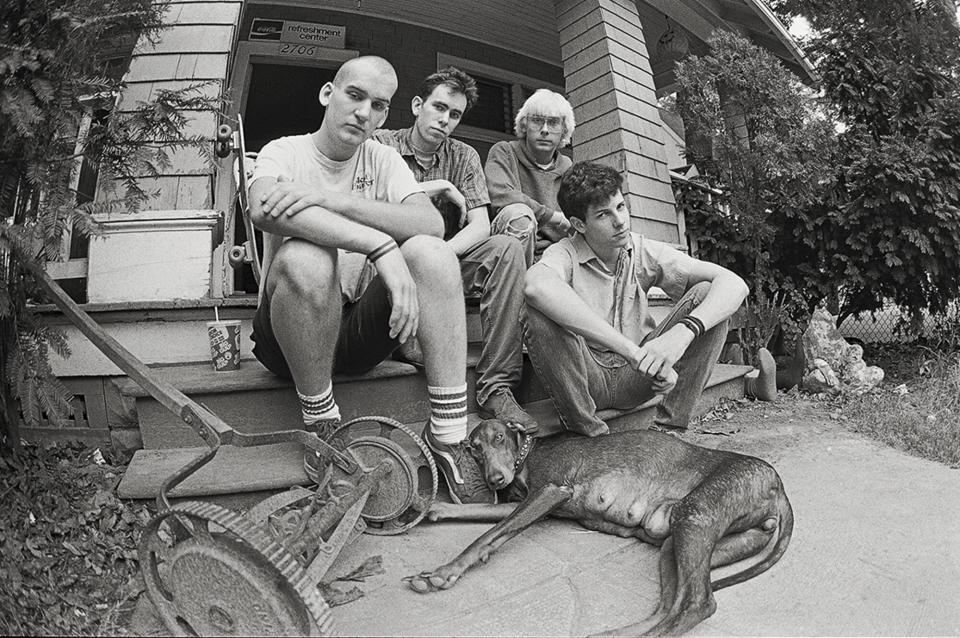The stories behind new never-before-seen Minor Threat photos

- Oops!Something went wrong.Please try again later.
- Oops!Something went wrong.Please try again later.
- Oops!Something went wrong.Please try again later.
- Oops!Something went wrong.Please try again later.
Minor Threat were not just a band. They were a movement. The hardcore — or harDCore — legends from Washington, D.C. not only helped usher in a brand of faster and louder punk rock along with fellow local chaos agents the Bad Brains; they also ignited a new wave of D.I.Y. ethos (releasing music on their own Dischord Records label) and personal accountability (their song "Straight Edge" inspired entire scenes to eschew alcohol, drugs, and casual sex).
While the influence of the group — which played from 1980 to 1983 and included singer Ian MacKaye, guitarist Lyle Preslar, bassist and guitarist Brian Baker, and drummer Jeff Nelson (and, for a spell, bassist Steve Hansgen) — is immeasurable, their musical output was not exactly prodigious: a single 21-minute album, two compilation songs, and three 7-inch EPs, one of which was released two years after they broke up. There has also been a scarcity of photographs of them, but that's about to change.
A teenage Glen E. Friedman began snapping pictures of the Dogtown skateboarding scene of the 1970s, getting up close to the airborne action taking place in the emptied-out swimming pools of Southern California. He later took his lens to the stage to capture a new breed of California punk bands like Black Flag, the Germs, Dead Kennedys, and Circle Jerks, and would eventually become one of the preeminent photographers of the 1980s New York rap scene, shooting LL Cool J, Run-DMC, and the Beastie Boys, as well as the cover of the greatest hip-hop album ever, Public Enemy's It Takes a Nation of Millions to Hold Us Back.

Glen E. Friedman Minor Threat
Along the way, Friedman also took one of the most famous punk-rock photos ever, of Minor Threat sitting on the porch of their practice space and record label headquarters ("Dischord House") in Arlington, Va. "I was trying basically for punk rock to mimic American Gothic," says Friedman of the shot (above) that would eventually become the cover of the band's "Salad Days" single. "That's what inspired me: this family of punk rock, this house, and this band that practiced in the basement there. That's what I was going for."
Why has the picture become so famous, with scores of fans making the journey to the house to take their own tribute photos? "The composition is perfect, the expressions are perfect, the character of Ian is just perfect," Friedman tells EW. "It spoke to people. I was just composing an image, placing things all over it to balance out this composition. Who knew 40 years later people would still want to try and get the lawnmower and the artificial limbs in the picture when they shot their own version. We created this thing that people related to and mimicked for years to come. I love seeing the memes and all that stuff."

Glen E. Friedman 'Just a Minor Threat' by Glen E. Friedman
While the "Salad Days" shot has secured its place in punk-rock history, Friedman has plenty of other pictures of the band that have never seen the light of day — until now. In October, Akashic Books will release Just a Minor Threat: The Minor Threat Photographs of Glen E. Friedman. Unlike in the digital age, when hundreds of stills can be captured in a matter of seconds, Friedman estimates his complete portfolio of Minor Threat amounts to less than 200 shots, and 140 of those images are in the book. "That makes me very proud that so much of what we made not only looks cool, but was composed in an interesting way and tells a story of the moment," says Friedman.
While other Friedman books like F--- You Heroes and My Rules are more curated collections of artists' work, in which he presented what he considered the best of the best, he decided to take a more comprehensive, completist approach on last year's What I See: The Black Flag Photographs of Glen E. Friedman, and that continues with Just a Minor Threat.
"When I made the Black Flag book, I became more open with work I made that isn't the perfection of what I want the world to see," Friedman says. "It's opened me up and made me more willing to share. And I think that's a good thing because there are a lot of great images that aren't perfect, but they should be seen and people want to see them. It makes no sense for them to just sit in my files."
Below, Friedman shares the stories behind some of the never-before-seen Minor Threat photos featured in the book.
The Barn (July 3, 1982)

Glen E. Friedman Lyle Preslar of Minor Threat in 'Just a Minor Threat'
"It was like a hydrogen bomb going off in a city," says Friedman of his first time seeing Minor Threat live on July 3, 1982 at the Barn at Alpine Village in Torrance, Calif. "I had been hearing the records for a little more than a year, but the way they came out on stage and the way the songs sounded live, it obviously was another experience. You don't know the personalities until you see them. You could hear it in the music, but there was no seeing it yet. There were no videos to watch ahead of time. So it was absolutely thrilling and inspiring."
So inspiring that Friedman shot two rolls of film instead of just one. One of those shots never seen before is of guitarist Lyle Preslar seemingly turning his wrath on… someone? "I have no idea what's going on there," says Friedman. "It was a very chaotic show, so maybe he was mad at someone for slamming into him while he was playing, or at the security for allowing someone to slam into him, or someone unplugged his guitar while he was playing, or Brian was not keeping up. You can't really tell."
Regardless, it's a great window into the passion and havoc of a Minor Threat show. "Lyle was a perfectionist," says Friedman. "I think he just wanted things to be a certain way, and at a show you often can't control that, and he is expressing his disappointment or bewilderment that everyone isn't following what he thinks should be happening. And so he's just like, 'What the f---?'"
As for what Preslar was actually yelling about in that photo, not even the subject knows for sure. "Either I'm screaming a line from 'In My Eyes' or I'm dismayed by the band because I'm looking in their direction," the guitarist tells EW. "I'd like to think it was the former. Either way, it's yet another example of Glen's ability to get the one-in-a-million shot."
9:30 Club (Aug. 1, 1982)

Glen E. Friedman Ian MacKaye of Minor Threat in 'Just a Minor Threat'
This shot of Ian MacKaye was taken at the original 9:30 Club in Washington, D.C. on August 1, 1982. How was seeing the punk outfit in their hometown different from other gigs? "As communal as the band always was, they were even more so at home because everybody knew them and had grown up with them," recalls Friedman. "The whole situation just seemed more relaxed and more comfortable. Not that it wasn't completely intense and chaotic as usual, but it was their club, their own stomping grounds. There was just a comfort level where there was less pressure than when they played in New York or Los Angeles."
To get the best shots in such a constantly-shifting scene, Friedman fell back on his roots in the medium. "Much like skateboarding, I just try to get as close to the action as possible. Whether it's in front of the stage or on the stage, I get as close to the subjects as I can and still see the environment they're in."
His previously unreleased shot of MacKaye above shows the singer in his element. As to how the frontman compares to his childhood friend and fellow hardcore legend Henry Rollins of Black Flag, Friedman says, "It's apples and oranges, right? Henry is very introverted, very intense, very strong, very menacing. Ian is also very strong, but he is more about sharing, more about being with the people and the crowd. They just speak in different languages and are great in different ways."
CBGB (Dec. 18, 1982)

Glen E. Friedman Ian MacKaye of Minor Threat in 'Just a Minor Threat'
Minor Threat's famous show at CBGB on Dec. 18, 1982 almost didn't happen — their van broke down on the way to New York, causing the group to arrive late to the gig. Only after Friedman and others pleaded to the club did the show go on. "Time was running out on the clock," recalls Friedman. "They weren't going to not let the band play because they weren't there on time, but they finally got there and we had made the case that you have to let the band go and play at least 15 minutes. Otherwise, everyone's going to f---ing tear this place down."
The club relented and chaos of another sort erupted. "Once Minor Threat was playing, they were such a force, you couldn't stop it. They let the show go on, and they played for about a half hour, when we thought they were only going to get 15 minutes just to calm everyone from destroying the place. But they played a phenomenal show."
In typical Minor Threat fashion, the band and crowd were intertwined as one, as shown in the never-before-seen photo from the performance above. But did that mass of bodies sometimes obscuring the group hinder Friedman's ability to get the best shots? "Did it make it more difficult to do what I wanted to do?" ponders Friedman. "I guess so, but that's not my concern. My concern is framing those moments that are going to inspire other people later the way I was being inspired." He wanted to capture the feeling in the room, including whoever was in it.
Los Angeles (April 1983)

Glen E. Friedman Minor Threat in 'Just a Minor Threat'
Friedman and Minor Threat didn't have anything specific in mind when they set out to take some pictures in between gigs in Los Angeles in April of 1983. "I have no idea why we did it," says the photographer. "I have no idea why I used the fish-eye that day, but we managed to get a couple of cool shots. There's a little more personality in some of them, and goofiness. They're not just super hard, and it's a little more personable."
These pictures also feature the addition of new bassist Steve Hansgen, with Brian Baker moving over to second guitar. "Black Flag had two guitars at the time, and once Black Flag put in two guitars, it was kind of a trend," says Friedman. "We all know that Brian was originally a guitar player and he switched to bass just for the band. It was kind of a thing at the time to get more power. Everyone wanted to do it. It turned out that most of them after a year or two went back to one guitar."
That includes Minor Threat, who eventually lost Hansgen and opted for their original four-person lineup. "Steve being in the band definitely lent more power to the live show," says Friedman. "He brought a lot of energy and that was great, but they didn't need it. They already had it. He fit in, and it worked for the time he was there, but then they realized it wasn't necessary and went back to what they were doing."
Dischord House (Aug. 2, 1983)

Glen E. Friedman Minor Threat in 'Just a Minor Threat'
Friedman's famous "Salad Days" shot was snapped on Aug. 2, 1983 at Dischord House. "I was very inspired by the communal aspect of the group house," says the photographer. "I had never lived in a group house myself, and it was a new concept to me, and I just thought it was really cool the way everyone gathered around this place and hung out there. I slept on the couch and woke up in the morning to everyone dancing and being goofy and putting on a show with broomsticks."
Plenty of other pictures taken that day appear in Friedman's new book, including the shot above with one of the band's canine fans. "The one of the dog is basically us goofing around," he says. "I'm always trying to get that moment where the composition and the character are perfect. But the one with the dog, it's not perfect at all. There is some personality in it, and that's cool, but it is a relatively ugly picture as far as I'm concerned. If you were a documentarian, that'd be a great picture, but that's not what I do, so that's why no one saw it."
But Friedman has put his high standards on hold to give a more complete portrait of the group. "I think it's stuff people would like to see, whether I like it or not," he says. "My Rules and F--- You Heroes are lots of perfect compositions, and those are my masterpiece books. But these books go in a little deeper and tell you a more whole story. I'm giving everyone everything, not just my precise art that I want people to see. I'm learning more and more as I get older that it's very valid to share that too."
Minor Threat fans will undoubtedly agree.
Just a Minor Threat: The Minor Threat Photographs of Glen E. Friedman is out Oct. 3.
Sign up for Entertainment Weekly's free daily newsletter to get breaking TV news, exclusive first looks, recaps, reviews, interviews with your favorite stars, and more.
Related content:

